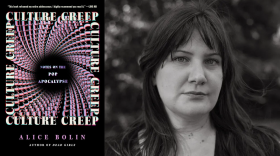This week on The Write Question, host Lauren Korn speaks with writer and translator Laura Marris, author of The Age of Loneliness (Graywolf Press).
About the book:
In this debut essay collection, Laura Marris reframes environmental degradation by setting aside the conventional, catastrophic framework of the Anthropocene in favor of that of the Eremocene, the age of loneliness, marked by the dramatic thinning of wildlife populations and by isolation between and among species. She asks: How do we add to archives of ecological memory? How can we notice and document what's missing in the landscapes closest to us?
Filled with equal parts alienation and wonder, each essay immerses readers in a different strange landscape of the Eremocene. Among them are the Buffalo airport with its snowy owls and the purgatories of commuter flights, layovers, and long-distance relationships; a life-size model city built solely for self-driving cars; the coasts of New England and the ever-evolving relationship between humans and horseshoe crabs; and the Connecticut woods Marris revisits for the first time after her father’s death, where she participates in the annual Christmas Bird Count and encounters presence and absence in turn.
This conversation has been edited for time.
About Laura:
Laura Marris is a writer and translator. She is a MacDowell fellow and the recipient of a Silvers Grant for Work in Progress. She teaches creative writing at the University of Buffalo. The Age of Loneliness is her first solo-authored book. Her translations include Albert Camus’s The Plague (Alfred A. Knopf; Vintage Books). With Alice Kaplan, she is also the co-author of a book of criticism about the novel called States of Plague: Reading Albert Camus in a Pandemic (University of Chicago Press).
Mentioned in this episode:
Gap Gardening by Rosemary Waldrop (New Directions)
Widows and Their Families by Peter Marris, Laura’s father (Routledge)
The poet Susan Howe, her work that touches on the archive
Laura’s translations of, and the work of, Paol Keineg
Morgenstern Books in Bloomington, Indiana (shout-out to bookseller Dalton!)
Laura Marris recommends:
Inheritance by Taylor Johnson (Alice James Books)
And Our Faces, My Heart, Brief as Photos by John Berger (Pantheon Books)
Borealis: An Essay by Aisha Sabatini Sloan (Coffee House Press)
The Grave on the Wall by Brandon Shimoda (City Lights Books)
The Second Body by Daisy Hildard (Fitzcarraldo Editions)
Visitation by Jenny Erpenbeck and translated by Susan Bernofsky (New Directions)
A Darker Wilderness: Black Nature Writing from Soil to Stars edited by Erin Sharky (Milkweed Editions)
Rivermouth: A Chronicle of Language, Faith, and Migration by Alejandra Oliva (Astra House)
“Standing at the Ruins” by Sofia Samatar (The White Review)
“The Site of Memory” by Toni Morrison, collected in Inventing The Truth: The Art and Craft of Memoir edited by William Zinsser (HarperCollins)
Lauren Korn recommends:
The Age of Loneliness by Laura Marris (Graywolf Press)
Braiding Sweetgrass: Indigenous Wisdom, Scientific Knowledge, and the Teachings of Plants (Milkweed Editions) and Gathering Moss: A Natural and Cultural History of Mosses (Oregon State University Press) by Robin Wall Kimmerer
No Archive Will Restore You (Punctum Books) and The Breaks (Coffee House Press) by a Julietta Singh
Aligning the Glacier’s Ghost: Essays on Solitude and Landscape (University of Mexico Press)
Borealis: An Essay by Aisha Sabatini Sloan (Coffee House Press)
Dark Laboratory: On Columbus, The Caribbean, and the Origins of the Climate Crisis by Dr. Tao Leigh Goffe (Doubleday, Penguin Random House)
A Darker Wilderness: Black Nature Writing from Soil to Stars edited by Erin Sharky (Milkweed Editions)
—
The Write Question team for this episode was Lauren Korn, host, co-producer, and editor; and Chris Moyles, co-producer, editor, and sound engineer. This episode is supported by Bookworks of Whitefish, offering new books of all genres, stationery, and puzzles. Open 11AM to 6PM Monday through Saturday. Located in downtown Whitefish, Montana, in the Third & Spokane Building.
The Write Question logo and brand (2022) was designed by Molly Russell. You can see more of her work at iamthemollruss.com and on Instagram @iamthemollruss.
Funding for The Write Question comes from Humanities Montana; members of Montana Public Radio; and from the Greater Montana Foundation—encouraging communication on issues, trends, and values of importance to Montanans.
The Write Question is a production of Montana Public Radio.






